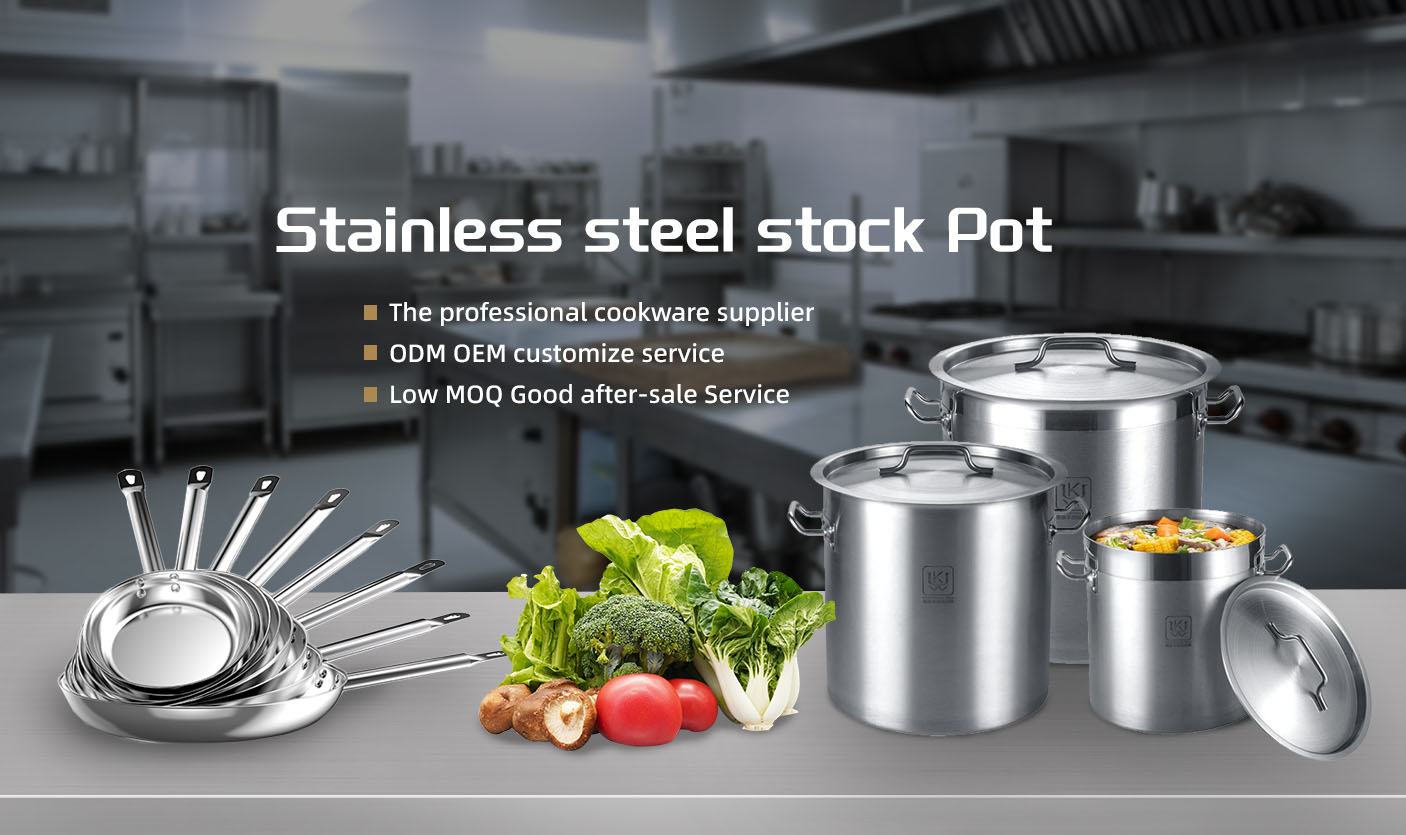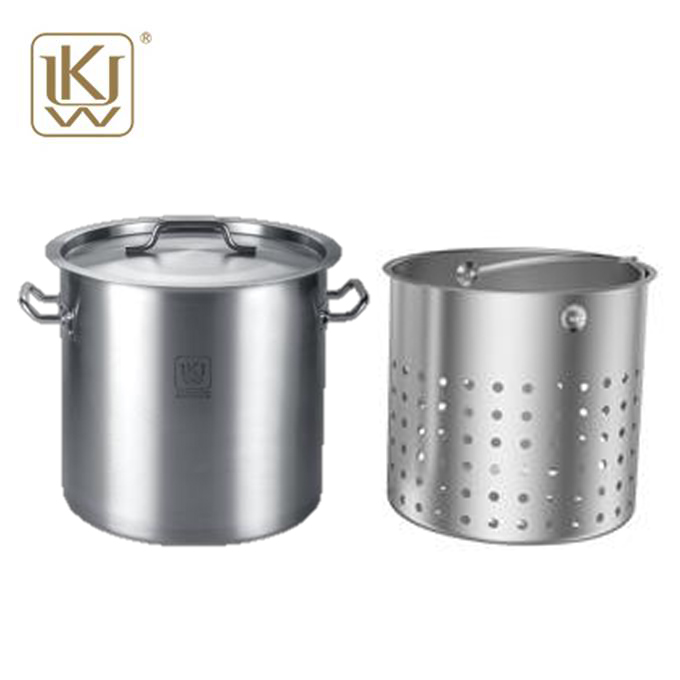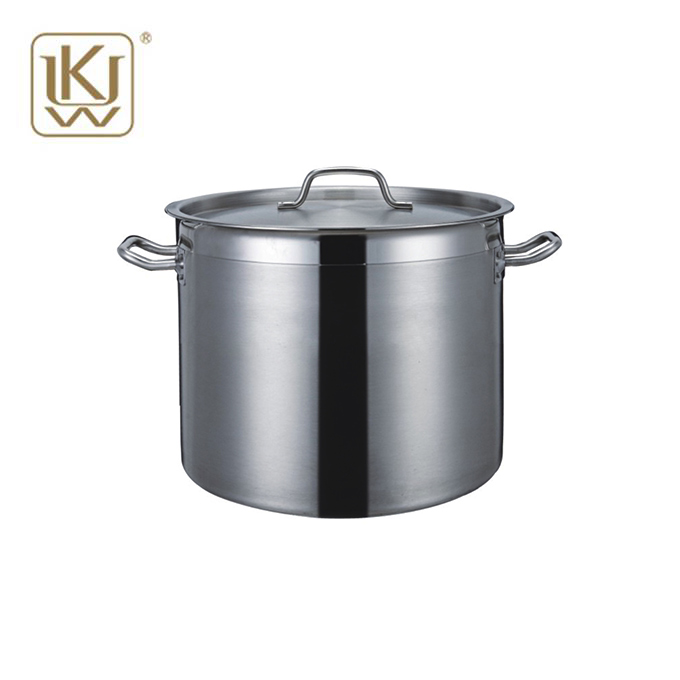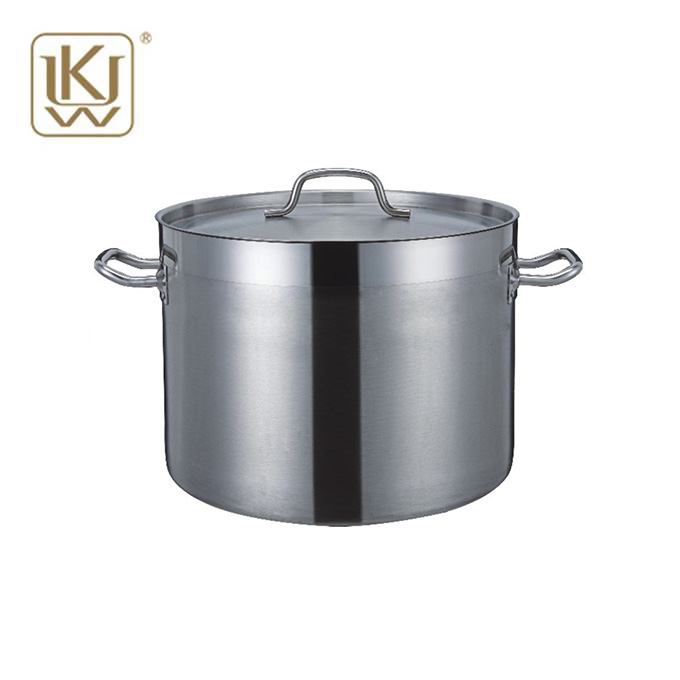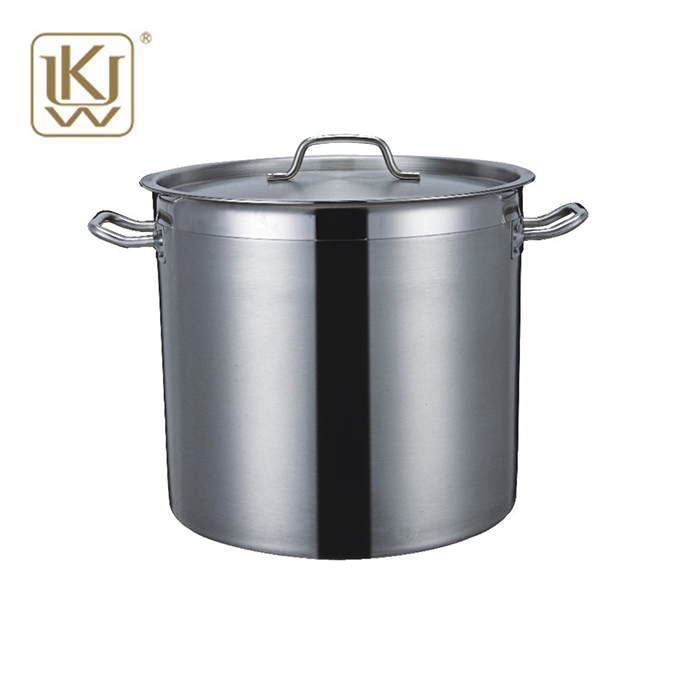Stainless Steel Soup Pot
- Product Information
The stainless steel soup pot is a large-capacity saucepan designed for both commercial and home kitchens. Constructed from high-strength stainless steel with a composite bottom structure, it boasts excellent heat resistance, stability, and thermal conductivity. Available in sizes from Φ200×H200mm to Φ600×H600mm, with capacities ranging from 6L to 170L, it caters to diverse needs from home cooking to large restaurant kitchens. The pot body is 0.8–1.0mm thick, and the bottom features a 4–5mm aluminum layer to ensure even heat distribution and prevent localized overheating. The overall design combines aesthetics and practicality, with a brushed finish that resists fingerprints and is easy to clean, making it an ideal choice for efficient cooking.
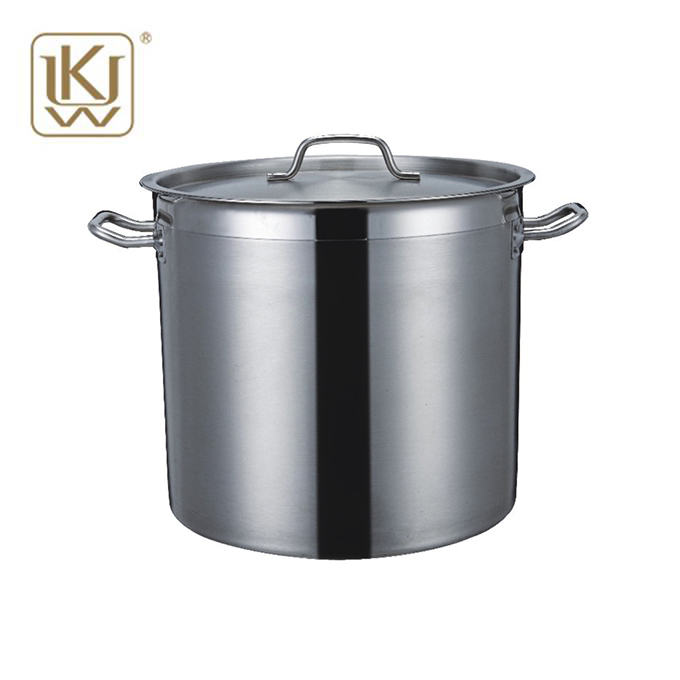
Stainless Steel Soup Pot Parameters:
| CODE 05 STYLE | Dimension | VOLUME | BODY & LID THICK(mm) | ALUMINUM THICK(mm) |
| SP202005 | Ф200*H200 | 6L | 0.8 | 4 |
| SP252505 | Ф250*H250 | 12L | 0.8 | 4 |
| SP282805 | Ф280*H280 | 17L | 0.8 | 4 |
| SP303005 | Ф300*H300 | 21L | 0.8 | 4 |
| SP323205 | Ф320*H320 | 25L | 0.8 | 4 |
| SP363605 | Ф360*H360 | 36L | 1 | 4 |
| SP404005 | Ф400*H400 | 50L | 1 | 4 |
| SP454505 | Ф450*H450 | 71L | 1 | 4 |
| SP505005 | Ф500*H500 | 98L | 1 | 5 |
| SP555505 | Ф550*H550 | 130L | 1 | 5 |
| SP606005 | Ф600*H600 | 170L | 1 | 5 |
Stainless Steel Soup Pot Features:
1. Premium Materials
The Stainless Steel Soup Pot is made of SUS304 stainless steel, with 18% chromium and 8% nickel, meeting food-grade safety standards. It remains rust-free after a 96-hour salt spray test, exhibiting corrosion resistance more than 25% better than ordinary steel.
2. Thickened Structure
The pot body is 0.8–1.0 mm thick, with a 4–5 mm thick high-purity aluminum composite layer at the bottom, improving heat conductivity by 30%. In heat conduction tests, it heats from room temperature to 100°C in just 2.8 minutes, demonstrating excellent temperature uniformity with a temperature difference of less than 2°C at the bottom.
3. Uniform Heat Conductivity
The bottom features a multi-layer composite structure, die-cast from stainless steel, aluminum, and stainless steel, with a thermal conductivity of 16.3 W/m·K, 2.5 times higher than single-layer stainless steel. Experiments have verified that the water temperature difference inside the pot is controlled within ±1.8°C after 5 minutes of heating, achieving efficient and uniform heating and preventing food from overcooking or sticking to the bottom.
4. Sealed and Energy-Saving
The lid and body feature a precise rolled edge structure, with a sealing error of no more than 0.5mm, reducing heat loss by approximately 22%. Tests show that after 30 minutes of heat preservation, the liquid temperature inside the pot only drops by 5℃, effectively maintaining the original flavor and temperature of the soup.
5. Durable Craftsmanship
Utilizing automatic argon arc welding and seamless polishing technology, the weld strength exceeds 180MPa, and no cracks or delamination were observed after 50 cycles of hot and cold cycling. The brushed surface layer has high hardness and strong wear resistance, maintaining a gloss retention rate of over 95% after 1000 wiping tests.
Stainless Steel Soup Pot Application:
1. Commercial Catering Kitchens
The Stainless Steel Soup Pot is suitable for high-capacity soup preparation in restaurant, hotel, and canteen kitchens. The 170L model can hold approximately 130 servings of soup at a time, meeting the needs of concentrated meal preparation. Its high thermal conductivity can save 15% on energy consumption, making large kitchen operations more efficient.
2. Home Kitchens
Suitable for home use in stewing soups, cooking porridge, or boiling seafood. Models from 6L to 21L are more suitable for family needs. The thickened bottom prevents scorching and has excellent heat retention, allowing soups to boil for a shorter time. Data shows that home users save an average of approximately 12% of cooking time per meal.
3. Food Processing Plants
Widely used in food processing for heating, mixing, and cooking raw materials. Models of 50L and above have stable heat conduction performance, ensuring that the temperature difference between heating batches does not exceed ±2℃, suitable for large-scale standardized production environments.
4. Medical and School Cafeterias
In centralized catering systems in hospitals and schools, the Stainless Steel Soup Pot is used for preparing nutritious soups or porridges. The thickened bottom layer prevents deformation of the pot bottom due to continuous heating, extending its service life. Even after 200 consecutive high-temperature cycles, the pot remains airtight.
Stainless Steel Soup Pot Maintenance:
1. Regular Cleaning
Wash immediately after each use to prevent food residue or salt from adhering to the bottom of the pot for extended periods. It is recommended to use warm water and a neutral detergent, and wipe with a soft sponge to prevent scratches on the brushed surface. Dry thoroughly after washing to prevent limescale buildup and white spots.
2. Avoid Dry Burning
Ensure there is sufficient liquid in the pot before heating to prevent dry burning, which can cause the bottom temperature to exceed 300℃ instantaneously, leading to stress fatigue of the metal structure. It is recommended to maintain a medium or low heat when using a gas stove to extend the pot's lifespan.
3. Moderate Heat
Stainless steel saucepans have high thermal conductivity and do not require continuous high heat. It is recommended to keep the cooking temperature below 220℃. Within this range, heat conduction is optimal, saving approximately 15% energy and maintaining a stable metal surface.
4. Use Dedicated Tools
Avoid using metal spoons, steel wool, or hard scrapers to prevent scratching the inner wall. Scratched surfaces are prone to micro-cracks. We recommend using cookware made of wood, silicone, or nylon. For stubborn stains, use a stainless steel cleaner, gently scrubbing in a circular motion.
5. Storage and Protection
After washing, keep completely dry and store in a well-ventilated, dry place. When stacking pots, place a soft cloth or paper mat between them to prevent scratches from friction. Periodically apply a small amount of cooking oil to the inside of the pots to form a protective film on the metal surface, reducing the oxidation rate and maintaining shine.
Stainless Steel Soup Pot FAQ?
1. What cooktops are suitable for this stainless steel soup pot?
The stainless steel soup pot is compatible with various heating methods, including gas, induction, ceramic, and halogen stoves. The bottom magnetic layer has been tested and shows a magnetic strength of 1200 Gauss, allowing for rapid induction heating on induction cooktops.
2. Will it deform under prolonged high-temperature use?
No. The pot body is made of 1.0mm thick stainless steel with a 5mm composite bottom. After 500 heating and cooling cycles, the deformation rate is less than 0.3%, maintaining a stable structure even in high-frequency commercial use environments.
3. Is it easy to clean?
Very easy. The inner wall has a smoothness Ra of 0.2μm, with less than 1% grease residue. It can be directly washed in a dishwasher, and after 500 washes, the surface shows no scratches or discoloration.
4. Is the lid airtight?
Excellent sealing. The rolled edge lid design has an error of only 0.5mm, reducing steam leakage by approximately 20% compared to traditional structures. It maintains a stable closed state even under high-pressure steam conditions.
5. Is it suitable for long-term simmering?
Excellent. The thick bottom and aluminum core layer ensure continuous and even heating, preventing the broth from scorching. Tests show that after simmering continuously for 4 hours, the temperature difference at the bottom of the pot is less than 2°C, and the soup maintains a stable taste and uniform color.


